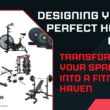With the growing popularity of health and fitness, more people are turning to the convenience and flexibility of home gyms. Designing your perfect home gym allows you to create a personalized space tailored to your fitness needs, schedule, and preferences.
Assessing Your Space and Budget
Before embarking on your home gym journey, it’s crucial to assess both your available space and budget. Determine the area in your home where you plan to set up your gym and establish a realistic budget for equipment and renovations.
Determining available space
Whether you have a spare room, a corner of your basement, or even just a portion of your living room, it’s essential to measure the dimensions of the space accurately. This will help you select the right equipment and plan the layout effectively.
Setting a budget
Creating a home gym doesn’t have to break the bank. Decide how much you’re willing to invest in equipment, flooring, and any other necessary upgrades. Remember to factor in ongoing costs such as maintenance and utilities.
Choosing the Right Equipment
Selecting the right equipment is key to maximizing your home gym’s effectiveness and versatility. Consider both essential pieces and optional accessories based on your fitness goals and preferences. https://www.gearforfit.com/ offers product recommendations for fitness gear, including apparel, equipment, and accessories. They provide insights into proper nutrition and diet plans to complement fitness routines. Gear for Fit aims to empower individuals to make informed decisions about their fitness journey by providing reliable information and recommendations.
Essential equipment for a home gym
Start with foundational equipment such as dumbbells, a quality exercise mat, and resistance bands. Invest in versatile pieces like a multi-functional weight bench and adjustable dumbbells to save space and money.
Optional equipment for added versatility
Depending on your interests and fitness level, you may want to include additional equipment such as a treadmill, stationary bike, or rowing machine. Think about incorporating accessories like stability balls, foam rollers, and yoga blocks to diversify your workouts.
Designing Your Layout
Once you have chosen your equipment, it’s time to plan the layout of your home gym. Maximizing space utilization and creating a functional flow will ensure an efficient and enjoyable workout environment.
Optimizing space utilization
Arrange your equipment strategically to allow for ample space to move around freely. Consider wall-mounted storage solutions for smaller items and foldable equipment to conserve space when not in use.
Considering flooring options
Investing in proper flooring is essential for protecting both your equipment and the underlying surface. Opt for durable, shock-absorbent flooring such as rubber tiles or interlocking foam mats to minimize noise and prevent damage.
Creating an Inviting Atmosphere
Designing a welcoming and motivational atmosphere in your home gym can enhance your overall workout experience and keep you coming back for more.
Lighting considerations
Ensure adequate lighting in your home gym to create a bright and energizing environment. Natural light is ideal, but if that’s not possible, opt for bright, LED fixtures that mimic daylight.
Adding motivational décor
Personalize your home gym with motivational quotes, posters of your favorite athletes, or even a vision board to inspire you during your workouts. Choose décor that reflects your fitness goals and personality to create a space that feels uniquely yours.
Setting Up Your Fitness Routine
With your home gym in place, it’s time to establish a regular fitness routine that fits seamlessly into your lifestyle.
Scheduling workouts
Consistency is key to seeing results, so schedule dedicated workout times that align with your daily routine. Treat your home gym sessions with the same level of commitment as you would a gym membership or fitness class.
Incorporating variety and balance
Mix up your workouts to prevent boredom and plateauing. Incorporate a combination of cardio, strength training, flexibility, and recovery sessions to keep your body challenged and balanced.
Safety Measures and Maintenance
Ensuring the safety of your home gym and its equipment is paramount for injury prevention and longevity.
Ensuring proper ventilation
Proper ventilation is essential, especially if your home gym is located in a confined space. Install fans or open windows to promote airflow and prevent overheating during intense workouts.
Regular equipment maintenance
Keep your equipment clean and well-maintained to prolong its lifespan and performance. Follow manufacturer guidelines for maintenance and inspect equipment regularly for signs of wear or damage.
Monitoring Progress and Adjustments
As you embark on your fitness journey, it’s essential to track your progress and make adjustments as needed to keep yourself motivated and on track towards your goals.
Tracking fitness goals
Set measurable goals such as weight loss, muscle gain, or improved endurance, and track your progress using a fitness journal or app. Celebrate your achievements along the way to stay motivated.
Reassessing equipment needs over time
As your fitness level evolves, you may find that your equipment needs change. Periodically reassess your home gym setup and consider upgrading or replacing equipment to better align with your goals and preferences.
Conclusion
Designing your perfect home gym is a rewarding endeavor that offers unparalleled convenience, flexibility, and motivation on your fitness journey. By carefully planning your space, selecting the right equipment, and creating an inviting atmosphere, you can transform your home into a fitness haven that inspires you to reach your health and wellness goals.




